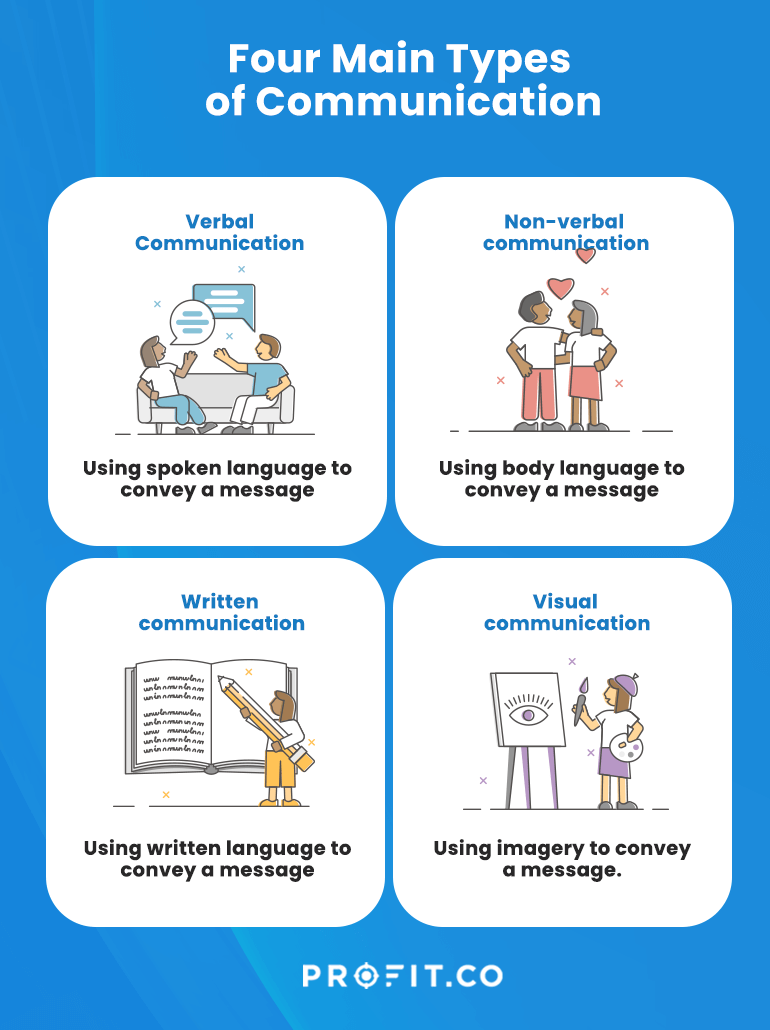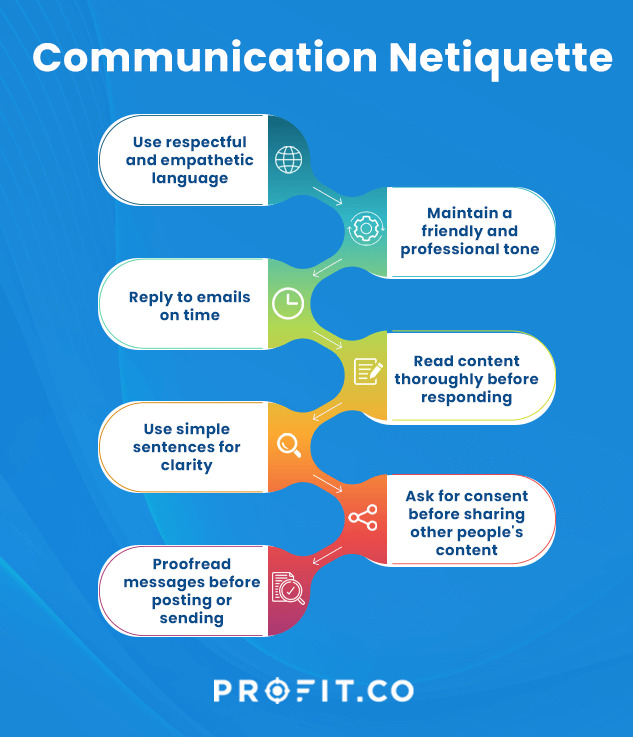Communication is the driving force behind all human interactions. It enables harmonious relationships at school, work, and in your personal life.
But what is communication, and how can we get better at it?
Let’s explore what communication is and the types, contexts, and skills necessary for mastering effective communication.
What is Communication?
Communication is the process of transmitting information from one party to another. It comprises a sender, recipient, and message, all subject to various influences that interfere with communication. There are four main types of communication. Some scenarios like a Conversation, Feedback, and Review (CFR) or a marriage proposal can take wrong turns just by poor communication.

The four main types of communication are the following.
1. Verbal communication
Verbal communication is the use of spoken language to convey a message.
Some examples of verbal communication are face-to-face communication, phone calls, or information passed through audiovisual media like TV or radio.
2. Non-verbal communication
Non-verbal communication is using body language to convey a message.
Some examples of non-verbal communication are gestures, posture, and tone.
3. Written communication
Written communication is using written language to convey a message.
Some examples of written communication include letters, emails, blogs, books, and other text forms.
4. Visual communication
Visual communication is using imagery to convey a message.
Some examples of visual communication include graphs, charts, infographics, maps, logos, and other representations.
The single biggest problem in communication is the illusion that it has taken place.
Bridge the Strategy Execution Gap with Profit.co
Elements of Communication
Communication consists of many factors, and mastering communication is a continuous process. Various communication elements are necessary to grasp the method of effectively conveying information.
Luckily, all communication types have the following eight features in common.
1. Source
The source is the origin of communication, typically a person who creates and sends the message through verbal, non-verbal, written, or visual media. They choose the right words, timing, and medium for their communication.
2. Message
Your message is the meaning you want to convey through words, speech, actions, or visual communication. The source encodes the meaning so the recipient will understand; otherwise, communication breaks down. For example, a message in English loses meaning to a Spanish-speaking audience.
3. Channel
The channel is how a message moves from source to recipient. Common communication channels include letters, videos, billboards, emails, public address systems, one-on-one conversations, tweets, and newspapers.
4. Recipient
A recipient is a person or audience who receives and interprets the message from the source. The recipient can either understand the meaning as intended or unintentionally misinterpret it. For example, constructive criticism may trigger hostility if the recipient has stress, experiences distraction, or has low self-esteem.
5. Environment
An environment is the physical or psychological atmosphere in which communication happens. A physical environment includes the location, such as a conference room, virtual classroom, stage, lighting, sound, and other equipment. A psychological environment has one’s culture, religion, values, mindsets, mental health, and emotions.
6. Context
A communication context means the expectations of the source and recipient, directly or indirectly affecting how a message is sent or received. For example, a business context sets expectations like formal attire and professional language. In contrast, a party context is more relaxed regarding dress code and language.
7. Feedback
Feedback is a message from the recipient to the source in response to communication. Feedback can also be verbal, nonverbal, or written to indicate whether the recipient understood the message accurately. If the message misses the mark, the source can clarify or try a different medium.
8. Interference
Interference refers to noise from physical or psychological sources interfering with the message. Physical noise can be car horns or construction sounds during a meeting; psychological noise can be intrusive thoughts that interfere with concentration.

Barriers to Communication
A communication barrier distorts your message at any point. When communicating, you might experience these roadblocks. Knowing them ahead of time will help you create solutions when encountering these challenges.
Examples of communication barriers include the following.
- Using jargon or complicated terms
- Lack of interest or motivation
- Disabilities like speech, hearing, or visual impairments
- Cultural and language differences
- Stereotypes and prejudices
- Power outages or internet downtime affecting communication tools
Communication Skills
Communication skills are capabilities that help you convey and receive messages effectively. These include verbal, non-verbal, and listening skills.
Let’s dive deeper into the three skills below.
1. Verbal communication skills
Verbal communication skills enable you to choose the right words to communicate the intended message and adjust these words to suit the listener. For example, you verbally communicate differently to a child, spouse, friend, colleague, manager, client, or group. As the recipient, verbal skills involve asking understanding questions, maintaining a conversation, giving feedback, and getting clarification from the source.
2. Non-verbal communication skills
Non-verbal communication skills enable you to use facial expressions, body language, tone, and other cues for effective communication. Since non-verbal communication can be subconscious, it can reinforce or undermine your message without you knowing it. All sorts of bias should be eliminated from the thought process. For example,Anchoring Bias can cloud the thinking and hence impact the outcome of the communication.
Improve non-verbal communication through practice: prepare your message beforehand, rehearse in front of a mirror, record yourself speaking, or have a friend serve as a sounding board.
3. Listening skills
Listening means more than just hearing; you must actively engage in understanding the message. Some active listening skills include maintaining eye contact to show interest, paraphrasing to demonstrate understanding, and asking open-ended questions to encourage clarification. Very often during a conversation effective feedback can be shared only after active listening.
Communication in Different Contexts
As the communication elements describe, context means the expectations surrounding a message.
Some examples of communication contexts are the following.
1. Physical context or setting
The location, time, weather, noise levels and overall setting impact communication.
For example, you would communicate differently at a library versus at a concert.
2. Past experiences or temporal context
Past experiences can impact your ability to communicate. For example, if a person arrives late for a work meeting because of a medical emergency, the stress and disruption of the experience impair their communication ability before the meeting.
3. Emotional context
Emotional context refers to the relationship between the source and recipient.
For example, a person may experience tension when speaking with a manager versus experience relaxation when speaking with a close friend.
These contexts affect communication, so knowing where each person comes from is essential to compelling your message.
Technology and Communication
Technology has a massive impact on communication in positive and negative ways. For example, communication today occurs much faster and reaches wider audiences through instant messaging apps and social media. It also enables remote working through video conferencing and collaboration tools.
Unfortunately, the instant nature of communication technology means too many messages compete for our attention, and often negative messages gain prominence. It’s also easier to communicate negative messages because devices make us anonymous.
One way to harness technology in communication is through netiquette (internet etiquette).
These practices guide online communication to promote respect and empathy for all parties, such as the following.
- Use respectful and empathetic language
- Maintain a friendly and professional tone
- Reply to emails on time
- Read content thoroughly before responding
- Use simple sentences for clarity
- Ask for consent before sharing other people’s content
- Proofread messages before posting or sending
OKRs and Communication to Power Strategy
OKRs, or Objectives and Key Results, is an organization’s goal-setting framework to drive focus, alignment, and performance. Initially popularized by Intel and later adopted by companies like Google, OKRs provide a clear structure for setting and tracking goals. In the interconnected business landscape world, effective OKR is the key to unlocking the true potential of strategy execution. An OKR communication strategy can be established within an organization to align teams toward a shared vision and drive remarkable success by establishing solid and engaging communication.
FAQs
- What is communication?
Communication is the process of transmitting information from one party to another. It comprises a sender, recipient, and message, all subject to various influences that interfere with communication.
- What are the four main types of communication?
The four types are verbal, non-verbal, written, and visual communication.
- What are the three essential communication skills?
The three essential communication skills are verbal, non-verbal, and listening skills.
Conclusion
While communication is complex, you now have the tools to master it effectively. The right communication skills can minimize misunderstanding and clarify your messages. Continuously honing your communication skills will create personal growth and growth for your organization.

